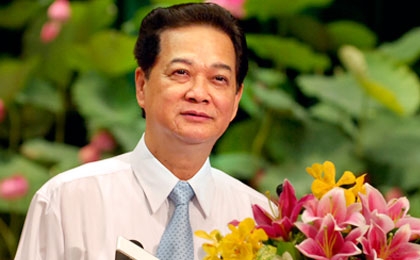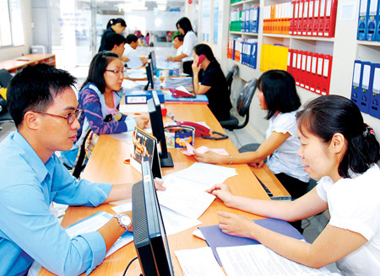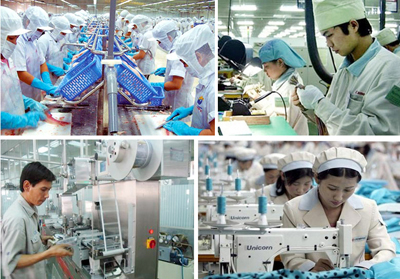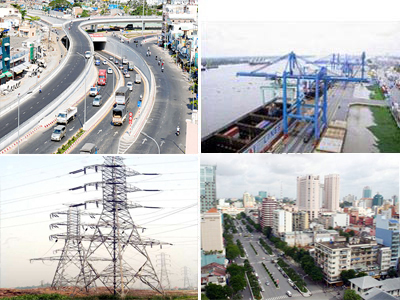PM raises central tasks for new cabinet
IMPLEMENT COMPETENTLY THREE STRATEGIC BREAKTHROUGHS DEFINED BY THE 11th NATIONAL PARTY CONGRESS IS THE GOVERNMENT’S PRIMARY MISSION IN 2011-2016 TERM
By HE. Nguyen Tan Dung
Politburo Member, Prime Minister
The 11th National Party Congress put forward the 2011-2020 socio-economic development strategy with the overall target of “striving to turn the country into a basically modernity-oriented industrialised one by 2020; with socio-politic stability, democracy, discipline, consensus ensured; the people’s material and spiritual life clearly and increasingly improved; independence, sovereignty, unity and territorial integrity maintained; Vietnam’s rising role in the international arena continued to be heightened further; and firm premises created for higher development in the next stage.”
The strategy came up with five stances, 12 development orientations, systemizing synchronously and completely mega targets, missions, and solutions in all spheres of economics, culture, social affairs, environment, national defense and security, external relations, etc, for sustainable development to be achieved. To create premises for successfully realizsng those targets and tasks, the strategy defined to make breakthroughs in three weak fields which are currently seen as knots hindering the development, as it realized that addressing well those fields will create a new momentum with radiating power to liberate all potentials and make the best use of resources to serve fast and sustainable development.
I
Promptly identify strategic breakthroughs - lesson learnt from innovation process
By the end of the 70s and early 80s of the previous century, our country dealt with critical contradiction (dilemma) between potentials and development requirements when it faced prolonged socio-economic crisis, the people struggled against a variety of difficulties in life, and production remained sluggish. The 6th National Party Congress put forth guidelines for innovation, underlining the importance of innovating the way of thinking, first of all in the field of economics. Innovation in economic thoughts allowed paved the way for us to abolish the centralised economic planning mechanism, subsidised and monopolised business of state-owned enterprises and co-operatives and shift to a market economy-based mechanism which saw the participation of businesses of different economic sectors and various ownership types. Accordingly, the national economy has developed lively with high growth rates achieved and the people’s life gradually improved. The transformation in mechanism helped tackle the contradiction the country did meet and truly became a strategic breakthrough. Thanks to this leading move, we successfully carried out the strategy for socio-economic stabilisation and development until 2000, taking the country out of crisis and creating a momentum for new and higher development.
 |
| Vietnam will successfully realise the three strategic breakthroughs for the fulfillment of the 2001-2020 socio-economic development strategy, says Prime Minister Nguyen Tan Dung |
The 9th National Party Congress approved the 2001-2010 socio-economic development strategy with three breakthroughs: (i) Building synchronously socialist-oriented market economy institution with the focus placed on the renovation of mechanisms and policies in order to absolutely emancipate production forces and expand domestic and foreign markets; (ii) Creating significant changes in human resources development, concentrating on education and training, science and technology; (iii) Renovating apparatus and working style of the political system, focusing on administrative reform and the building of strong and transparent state apparatus.
After ten years we gained significant achievements. Our country escaped from the poor and less-developed status to enter the group of middle-income nations. The institution of market economy was basically formed, different types of markets gradually developed nationwide in a synchronous manner and increasingly integrated into the global market. The scope of education and training increased rapidly, the quality of the workforce reaped substantial improvements. Administrative reform, particularly administrative procedures reform were drastically deployed and attained positive results, making it convenient for people and businesses to carry out transactions and production activities.
However, beside the achievements, shortcomings and weaknesses still remained, as reflected especially in the organisation of the implementation of the breakthroughs which was yet to be really undertaken in a drastic and synchronous manner, remaining to be carried out progressively, and also in production power which was not fully liberated. Such shortcomings and weaknesses have imposed barriers to fast and sustainable development and needed concerted efforts to be addressed. Thus, the 2011-2020 socio-economic development strategy singles out three breakthroughs, namely: (i), perfecting the institution of socialist-oriented market economy, focusing on creating an equal competition environment and administrative reform; (ii) quickly developing human resources, particularly high-quality workforce, focusing on basically renovating the national education system and closely combining human resources development with the development and application of scientific and technological advances; and (iii) developing a synchronous system of infrastructural facilities with a number of modern works, focusing on transport system and infrastructure in big urban areas.
II
Focus on realising strategic breakthroughs, create premises for restructuring the national economy, and transform growth models - the government’s central tasks in the 2011-2016 term
1. Perfecting the institution of the socialist-oriented market economy, with the focus on the creation of an equal competition environment and administrative reform
Basis requirements for the market economy institution to fully promote its active dimensions are the full formation of elements of the market economy, the synchronous development of various types of highly transparent markets which are well managed and supervised; with such features, the market is able to make dynamically balanced allocation of resources for production and service sectors in accordance with signals generated by the market to ensure economic efficiency. Without these conditions, the market is unable to produce correct signals and resources can not move freely, consequently affecting businesses’ full exploitation of their potentials and the economy’s performance as well. The 2011-2020 socio-economic development strategy defined: Perfecting the synchronous and modern institution of the market economy is important pre-condition for accelerating the process of economic restructuring, growth model transformation, and macro-economic stabilisation.
An important criteria used to measure how far the institution of the market economy develop is levels of competition in production and service fields. Competition reveals capacity of economic entities. In a competitive environment, participating businesses must fully utilise their comparative advantages and transform these comparative advantages into competitive advantages; at the same time, they always need to seek ways and means to create new competitive advantages in order to ceaselessly improve the efficiency of capitalising on various resources, expanding market outlets, and developing production and business capacity. This is a new philosophy of growth – to which growth is based on competition.
| |
| Strong administrative reform, including administrative procedures reform is one of the central tasks of the new term of the Vietnamese government |
A task set out for the 2011-2016 term is the continuation of perfecting mechanisms and policies so as the commodity market, service market, financial market, securities market, real property market, labor market, science and technology market are founded synchronously and operate smoothly with a high degree of competitiveness, increasingly linked with the global market and effectively managed and supervised. The process of synchronous formation of the institution of the market economy following the above-mention requirements must be coupled with the minimisation of business monopoly in the production and service fields, and the establishment of an equal competitive environment for different economic sectors. This is the two inseparable sides of a process. It is a must to clearly identify economic branches where monopoly still remain largely in order to outline proper policies and solutions to enable the participation of private sectors. State-owned enterprises must be renewed strongly to compete with other economic sectors equally and no longer enjoy subsidies and special treatments they are currently still given; state-owned enterprises’ operations must be made transparent under the criteria applied for businesses operating in the securities market. The mechanisms mandating the state ownership over state-owned enterprises must be renovated in the direction that policy making agencies will not concurrently function as the owners of businesses.
In the context when economic linkages experienced basic changes, globalisation was stronger and broader, economic relations increasingly complicated with unexpected changes, more risks and growing instability, the above requirements cannot be well achieved unless a high-quality institutional system is shaped. Thus, it is a need to strongly reform the national administrative regime in all aspects: institution, apparatus, administrative procedures, and public finance in relation with a proper and effective system of decentralisation in order to raise the quality of public governance - one of the weak points still existed in management in our country. Transparency and forecasting capacity must be enhanced to minimise instability and risks for investors as well as avoid speculation and prevent and stamp out corruption, and reduce transactional costs for businesses. People and businesses are encouraged to increasingly engage in the making of policies and institutional building; the role of social debates and state agencies’ interpellation responsibility in making policies and evaluating the efficiency of law enforcement should be heightened.
It needs to change the way of thinking and access approach when identifying the role of the state and its relations with the market. The state should shift from the role as a regulator of the national economy to a builder of development. In the new role, the function of the state is to build development planning schemes dominated by a correct industrialisation and modernisation strategy; to create room and conditions for different economic sectors to fully promote their potentials in a competitive environment and international integration; and to expand supervision to quickly uncover macro-economic imbalances that may arise to secure macro-economic stability and safety for the entire system. That is why the 11th National Party Congress determined that the establishment of an equal competitive environment and the undertaking of administrative reform were the key in institutional breakthrough.
In the process of perfecting the institution of the market economy, special attention must be given to the socialist nature of the national economy we are building. It needs to have a correct awareness on the operation of the market that is it operates under its own rules. The market has it own negative effects and it can not itself generate socialist orientations for development. This function must belong to the state. The state, through its planning schemes, plans, policies and regulatory tools, allocates resources for branches, sectors, and regions and areas to ensure economic growth in combination with poverty reduction and social progress and equality; pays due attention to cultural and social development in harmony with economic development. In the next five years, more investment must be poured to agriculture and rural development, the programme on building new-style rural areas should be effectively implemented, cultural area should be paid due investment in order to become a real spiritual foundation of society and an impetus for economic development. Efforts are required to focus on perfecting and expanding the social security and welfare system effectively to assist vulnerable groups in the market economy and international integration, ensuring that all people benefit from growth-generated fruits.
2. Developing quickly human resources, particularly high-quality workforce in close combination with scientific and technological development and application
We are living in an era characterised by three major economic features governing each nation’s development. They are: (i) science and technology evolvement which is stronger and quicker than ever. This advancement creates the third wave of industrialisation and forms knowledge-base economy; (ii) globalisation has increasingly deepened and economic linkages have emerged rapidly, stepping up the division of labor deeply and forming global value chains; economic competition has taken place fiercely and each nation must grasp advantages in that competition; (iii) the scarcity of raw materials and energy due to the exhaustion of non-recycled natural resources requires human kinds to seek new types of raw materials and energies to ensure sustainable development.
The features mentioned above underlines the rising role of human resources – a competitive advantage in the development process and a factor helping shift comparative advantages between nations. That situation either sets forth requirements or creates conditions for the transformation of growth model, from the one depending mainly on investment capital increase, exploitation of natural resources and cheap, low-quality workforce to the one which works on the basis of collective productivity, including the capacity to apply up-to-date scientific and technological achievements, the quality of human resources and modern managerial skills. The key to the transformation - the central factor of the process is the high-quality workforce. The 2011 - 2020 strategy identified: Fast development of human resources, particularly high-quality workforce, etc, in close combination with human resources development and the development and application of science and technology is a strategic breakthrough, and it is decisive factor for restructuring the economy, and transforming the growth model and the most important competitive advantage securing fast, effective and sustainable development. In the ultimate, this is the most important among three breakthroughs, taking the leading role in realising the remaining two breakthroughs as it is human being who create and implement institution, develop apparatus, plan and build infrastructure. Good implementation of this breakthrough will enhance the nation’s soft power and create a synergy with decisive influence on the building of an increasingly independent and self-reliant economy in the context of increasingly wide and deep international integration – an important guideline set by the 11th National Party Congress.
| |
| The quality of human resources would decide how long the strategy for industrialisation and modernisation would be implemented |
Lessons learnt from other countries have showed that a nation that knows how to well develop and promote human resources can successfully carry out industrialization and modernisation strategy in shorter period of time. Over the past years, we have taken a series of measures to develop human resources and have achieved significant outcomes. However, the work still contains shortcomings such as high rate of untrained workforce, low training quality, and improper professional structure. We are short of state management officials and business managers, experts for both technical professions and economic sectors, as well as skilled workers. They are big hindrances to the process of industrialisation, modernisation and international integration.
The strategy clearly pointed out that, special attention must be given to the development of excellent leaders, managers, experts, business executives, skilled workers, and leading scientists. The training of human resources needs to meet a variety of needs and multi-levels of technologies and development levels of sectors and branches. Businesses, training establishments and the state need to team up to develop human resources with regard to the market demand. Programs and projects to generate high-quality workforce for key and spearhead sectors need to be carried out. Due attention should be given to discovering, nurturing and promoting the talented; Human resources in service of the development of knowledge-based economy need to be developed
Human resource development is both urgent and long-term tasks along with the evolvement of knowledge of human kind. In the next five years, priority must be placed on formulating and deploying a programme that centers on basic and comprehensive renovation of the education system in the direction of standardisation, modernisation, mobilisation of widespread social engagement, democratisation, and international integration, in which, the renovation of education management mechanisms and development of teacher and manager teams are vital solutions. Special consideration should be given to training high-quality workforce to serve economic restructuring and growth model transformation. Improvement of education and training quality is the central task in combination with proper expansion of education scope. Care should be paid to educating morality and lifestyle, promoting creativity, practical skills, and ability to make a living. Financial regime needs to be renovated; Education and education quality at all educational levels needs to be verified. Healthy educational environment that establishes a close bond between schools, families and society needs to be developed.
The new emphasis of this breakthrough is to mainstream human resources development, particularly high-quality workforce into the combination of the development and application of science and technology. This demonstrates the goal-orientating purpose of scientific and technologicial development, securing the transformation of human resources’ brainpower potentials into fruits of scientific and technological application and creation – the key driving force to drive fast and sustainable development process.
In the 2011 – 2016 term, the government will strongly and synchronously reform apparatus, management and operation mechanism s of the science and technology sector; direct scientific and technological activities to serve industrialisation and modernisation, growth model transformation, thus contributing to quickly increasing productivity, quality, efficiency and power of the national economy. It will promulgate policies to encourage businesses to renovate technologies with priorities given to energy-saving, environmentally friendly, and green ones.
3. Developing a synchronous infrastructure system with a number of modern works, focusing on transport network and infrastructure in big urban areas
Infrastructure serves as a pathway for socio-economic development, and a condition for the allocation of production forces and the facilitation of goods circulation. A synchronous infrastructure system will expand development space, connect economic regions, and enhance socio-economic development efficiency. Over the past years, we have mobilised various resources for the development of infrastructure, significantly contributing to socio-economic development, and poverty reduction in every corner across the country. However, the infrastructure system is still weak and out of date. The planning schemes and construction were made asynchronous, investment was scattered, and connectivity of different vehicles, between domestic regions and with international transport lines have proved limited. The bigger the scale of the economy and the faster the speed of the urbanisation process, the more inadequacies in our infrastructure, especially those in the transport system and urban infrastructure, which will increase costs, reduce competition capacity and hinder national growth. Therefore, the 2011-2020 socio-economic development strategy said: Developing a synchronous infrastructure with a number of modern works, focusing on the transport system and urban infrastructure, is a breakthrough.
| |
| Infrastructure is the path for socio-economic development and condition for allocating production forces |
The implementation of this breakthrough requires changes of the stage of planning, priority selection, and methods to mobilize resources to the implementation procedures.
The distribution of the population and production forces should be associated with the nationally envisioned urbanisation process. The local-level demand for infrastructure development is very high. With limited resources, we should not make decision just on what we want, but on what is the best in order to clear traffic bottlenecks and achieve the highest economic outcome in the shortest time as possibly as we can. Therefore, the infrastructure development plan for 2011-2015 will be in the following directions:
Firstly, focus investment on the North-South route. Priority should be given to the development of transport systems in areas with high cargo capacity, localities located in growth destinations, and connecting with regional and international areas in order to create powerful domino effect, boosting national growth. Also, we must modernise and improve collective services in the three major ports of three regions: Haiphong, Ho Chi Minh City-Vung Tau and the Central Region, and form large marine economic centers. Associate rural infrastructure development with our new rural development program, and pay attention to addressing urgent needs for the production and circulation of goods, transportation, and flood prevention in mountainous and ethnic areas.
Secondly, concentrate on upgrading and modernising our comprehensive infrastructure in association with urban layout, restructuring of production as well as distribution of population. We must improve our urban transport systems, especially public transportation, and tackle congestion and flooding issues in Hanoi and Ho Chi Minh City.
Thirdly, quickly develop the power resource and transmission systems in couple with the promotion of energy-saving technology in order to provide sufficient energy to serve national growth and meet the people’s daily needs.
Fourthly, focus on synchronous development and gradual modernization of the irrigation systems, including measures to strengthen our sea and river dykes, pumping stations, and other flood prevention and drainage works. Focus on disaster prevention and construct anchorage areas to mitigate natural disaster damages for the people. Modernise our information and communication sectors and information technology infrastructure to meet development requirements and contribute to enhancing labor productivity.
The government will concentrate more efforts on perfecting investment mechanisms and policies, including those on the mobilisation of resources, investment regulations and public procurement. We must mobilise more capital from the people for infrastructure development; promote the social participation in investment and diversification of investment models. Encourage and create conditions for economic sectors, including foreign investors, to participate in infrastructure development, and for boosting the implementation of effective investment methods such as build-operate-transfer (BOT), build-transfer (BT), and especially public-private partnership (PPP). Meanwhile, continue to research and acquire international experience in building new, synchronous and appropriate mechanisms and policies for infrastructure development.
The investment process and procedures need to be innovated to accelerate the progress of projects, enhance the quality of construction designs, strengthen supervision, ensuring construction quality and investment efficiency, and improve the capacity of individual units.
Under the leadership of the Party, by raising the efficiency of the state management, promoting the people’s right to mastery, and implementing the principle “people know, people discuss, people do, and people supervise” toward the people’s role as the owner of the development process, we will certainly succeed in implementing the three strategic breakthroughs, thereby making crucial premises for successful implementation of the 2011-2020 socio-economic development strategy.
What the stars mean:
★ Poor ★ ★ Promising ★★★ Good ★★★★ Very good ★★★★★ Exceptional
 Tag:
Tag:
Related Contents
Latest News
More News
- Vietnam’s green transition demands collective financial action (December 15, 2025 | 12:00)
- VIR workshop highlights capital and policy for sustainable development (December 15, 2025 | 11:00)
- National Assembly approves pilot mechanisms to accelerate major projects in Hanoi (December 12, 2025 | 11:29)
- Vietnam eases policy approval requirements, simplifies foreign and outbound investments (December 11, 2025 | 17:53)
- Unpacking new momentum in Vietnam’s M&A market (December 10, 2025 | 09:59)
- Forum honours outstanding M&A deals, strategies, and advisory firms (December 09, 2025 | 18:22)
- Vietnam enters defining phase of M&A growth (December 09, 2025 | 17:00)
- Vietnam’s M&A market opens new opportunities amid strong economic momentum (December 09, 2025 | 15:00)
- Vietnam M&A Forum 2025: new position, new momentum (December 09, 2025 | 14:30)
- FDI in Vietnam jumps on additional capital and share purchases (December 09, 2025 | 13:56)



























 Mobile Version
Mobile Version